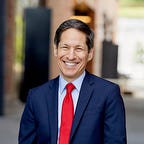Ending the Tobacco Epidemic
With public health action, we can save more than eight million lives a year. The only loser? Big Tobacco.
It’s been more than 20 years since New York City’s Smoke-Free Air Act was passed. This was during my first year as NYC Health Commissioner. It was a hard-won battle to make workplaces, including restaurants and bars, smoke-free. Big Tobacco fought us intensely.
Despite growing evidence that exposure to secondhand smoke was deadly, there was virulent opposition from smokers and the tobacco industry. Many people, led by NYC Mayor Michael Bloomberg, put their political futures and reputations on the line to support the ban. Now, decades later, the Smoke Free Air Act’s transformational impact — and the precedent it set all over the world — has saved millions of lives.
Smoke-free workspaces, restaurants, and bars not only encourage quitting but also shift social norms. It’s no longer acceptable to expose others to secondhand smoke. Smoke-free laws make the healthy choice the default option. These laws protect hundreds of millions of people from cardiovascular disease, respiratory illness, and cancer.
This was a sea-change in perceptions, recognizing that what had seemed a nuisance — second-hand smoke — is deadly.
Smoke-free laws are now in place in 36 U.S. states and 74 countries protecting more than a third of the world’s population from secondhand smoke.
Yet the tobacco epidemic continues. Big Tobacco is tenacious, always looking for new ways to get their poisonous products into new hands and lungs. I had thought they never change, but I was wrong. They get even more devious.
With proven public health action, we can end this deadly epidemic.
Applying the “Swiss Cheese Model”
Smoking bans alone aren’t enough. We need to apply the “Swiss Cheese model” to the fight against tobacco, using a range of approaches instead of relying on one intervention. The World Health Organization’s MPOWER framework does this by laying out a clear-cut pathway for countries to reduce tobacco use.
— Monitor tobacco use
— Protect people from tobacco smoke
— Offer help to quit
— Warn about the dangers of tobacco
— Enforce bans on tobacco advertising
— Raise taxes.
It’s simple, really — go smoke-free in all public places, ban all advertising, promotion, sponsorship and displays, use all means to get the message of how deadly smoking is out, help smokers quit, and, most importantly, raise tobacco taxes.
NYC raised tobacco taxes, made restaurants, bars, and other public places smoke-free, ran hard-hitting anti-tobacco ads, helped smokers quit, and provided people with resources to quit.. This reduced adult and teen smoking rapidly and prevented more than 100,000 deaths. These efforts truly showcased MPOWER’s impact as we watched the number of smokers and smoking-related death and disease decrease steadily. Smoking rates among NYC adults declined 28% from 2002 to 2012, and by more than half among youth.
More and more countries are adopting the MPOWER strategy. Since 2007, the number of countries with at least one measure in place has tripled from 44 to 151, with nearly half enforcing comprehensive smoke-free policies.
Taxation is the most effective way to reduce smoking. In recent years, nearly every U.S. state has increased tobacco taxes, with the average tax now nearly $2.00 per pack. These taxes not only reduce smoking and save lives but also raise revenue, making it a win-win. The only loser is Big Tobacco.
Lingering Challenges and a Way Forward
Smoking rates in the United States are at the lowest level ever measured, but we still have a long way to go. More than 28 million U.S. adults still smoke cigarettes, 1,600 kids try their first cigarette every day, and 16 million people live with a serious illness caused by smoking.
The United States now faces a youth vaping epidemic thanks to the introduction of e-cigarettes and sweet and fruity flavors. These products make it easier to get hooked and harder to quit, building a 2.8 million-strong population of nicotine-addicted youth.
Although the U.S. Food and Drug Administration (FDA) started regulating e-cigarettes in 2016 and recently proposed banning the sale of menthol cigarettes, traction has stalled as the tobacco industry fights back. And this isn’t just in the U.S. All over the world, Big Tobacco continues to interfere with efforts to reduce smoking, working to roll back existing bans, weaken regulation, and delay taxation. They aren’t backing down, and nor should we.
Tobacco companies engineer cigarettes to be addictive. Ending addictive levels of nicotine in cigarettes would be a game changer. Congress granted the FDA the authority to do this in 2009, but the FDA has yet to make it happen.
We need to push those in power to end the tobacco epidemic. We need the FDA and their global counterparts to regulate e-cigarettes and ban the sale of flavored cigarettes. We need to continue increasing tobaccos taxes. And we must remove nicotine at addictive levels from cigarettes.
Compared with the continued spread of COVID-19 and other pressing health threats, the slow burn of the tobacco epidemic feels less urgent. But ending it can save more than 8 million lives every year.
The world needs advocacy, government action, and sustained support to win this fight. We can do this!
